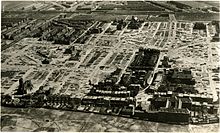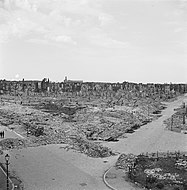Bombing of the Bezuidenhout
| Bombing of the Bezuidenhout | |||||
|---|---|---|---|---|---|
| Part of World War II Operation Crossbow | |||||
 Bezuidenhout burning, shortly after the bombing, photographed from the tower of the Church of James the Greater, at Parkstraat in The Hague | |||||
| |||||
| Belligerents | |||||
|
|
| ||||
| Commanders and leaders | |||||
| Air Marshal Sir Arthur Coningham[not verified in body] | |||||
| Units involved | |||||
|
| |||||
| Strength | |||||
| 56 Boston & Mitchell bombers[2] | |||||
| Casualties and losses | |||||
|
Bezuidenhout civilian casualties (collateral damage): | |||||
Location within South Holland | |||||


The bombing of the Bezuidenhout (Dutch: bombardement op het Bezuidenhout) took place on March 3, 1945,[7] when the Royal Air Force mistakenly bombed the Bezuidenhout neighborhood in the Dutch city of The Hague, resulting in the death of 532 people.[8][9]
Bombing
[edit]On the morning of March 3, 1945, 51 medium and light bombers of the North American B-25 Mitchell and Douglas Boston types from No. 137 and No. 139 wings of the Second Tactical Air Force took off from Melsbroek near Brussels and Vitry in Northern France with a payload of 67,000 kg of high-explosive bombs.[10][9][11]
The British bombers were intended to bomb the Haagse Bos ("Forest of the Hague") district where the Germans had installed V-2 launching facilities that had been used to attack English cities.[12][13] However, the pilots were issued with the wrong coordinates (vertical and horizontal interchanged),[9][11][12] so the navigational instruments of the bombers had been set incorrectly, and combined with low fog and clouds which obscured their vision, the bombs were instead dropped on the Bezuidenhout residential neighborhood.[9][12] Eventually, a wind force of 9 instead of the expected 5 added to the catastrophe.[12] All bombs missed the rocket installations in the 2.4 km (1.5 mi) x 0.8 km (0.50 mi) forest target (Haagse Bos)[14] by 1.2 km (1,300 yd)[9] ("incorrect allowance for the wind"[15]/"map-reading error"),[2] and hit the Bezuidenhout neighborhood instead.[4][16][17]
At 9:08 a.m. the 51 bombers dropped 67 tons of high-explosive bombs on the Bezuidenhout,[9] wreaking widespread destruction.[18]
"Everyone went out and into the street. You saw people running, running, running everywhere. But whichever way you ran, there was fire everywhere."
— Survivor, [13]
At the time, the neighborhood was more densely populated than usual with evacuees from The Hague and Wassenaar; tens of thousands were left homeless and had to be quartered in the Eastern and Central Netherlands.[10]
Response
[edit]Due to insufficient fire engines and firefighters (as many of them had been either called up for forced labor in German industry or had gone into hiding to prevent being signed up)[9] the resulting fire was largely unchecked,[19] killing 511 people,[4] including ten firefighters at the Schenkkade.[9] In total 532 people were killed by the bombing.[9][3]

As soon as the British realized the extent of the damage, they dropped fliers over the neighborhood expressing condolences for the civilians who were killed by their error.[12][20] Trouw, the Dutch resistance newspaper, reported:
The horrors of the war are increasing. We have seen the fires in The Hague after the terrible bombings due to the V2-launching sites. We have seen the column of smoke, drifting to the south and the ordeal of the war has descended upon us in its extended impact. We heard the screaming bombs falling on (the) Bezuidenhout, and the missiles which brought death and misery fell only a hundred metres from us. At the same time we saw the launching and the roaring, flaming V2, holding our breath to see if the launch was successful, if not falling back on the homes of innocent people. It is horrible to see the monsters take off in the middle of the night between the houses, lighting up the skies. One can imagine the terrors that came upon us now that The Hague is a frontline town, bombed continuously for more than ten days. Buildings, burning and smouldering furiously, a town choking from smoke, women and children fleeing, men hauling furniture which they tried to rescue from the chaos. What misery, what distress.[20]
Commemoration
[edit]

The bombing is commemorated every year on the first Sunday after 3 March. In 2011, Mayor Jozias van Aartsen[21] of The Hague as well as the Mayors of Wassenaar and Leidschendam-Voorburg (residents of both towns helped with firefighting and caring for the survivors) were present at the remembrance ceremony, which consisted of a church service, the laying of a wreath at the Monument of the human mistake (Dutch: Monument van de menselijke vergissing) and a remembrance concert in the Royal Conservatory of The Hague.[22] A similar church service and concert were held in 2012.[23]
Casualties, losses, and damage
[edit]- 532 fatalities[3]
- 344 wounded
- 30,000 people left homeless[5]
- 3,300 completely destroyed residences
- 3,250 burned out residences
- 3,241 damaged residences
- 391 irreparably damaged residences
- 290 completely destroyed businesses
- 5 completely destroyed churches
- 9 completely destroyed schools
- 10 completely destroyed public buildings[9][4]
Gallery
[edit]-
Unknown street in Bezuidenhout, after the bombing
-
Juliana van Stolberg monument and ruins of the Wilhelmina Church
-
Unknown street in Bezuidenhout, after the bombing
-
Laan van Nieuw Oost-Indië (street)
-
The intense fire caused numerous buildings to collapse entirely
-
In the background: ruins of the Church of Our Lady of Good Counsel at Bezuidenhoutseweg (street)
-
Korte Voorhout (street) at the old city center
-
Ruins of the Anglican Church of St. John and St. Philip in The Hague, after the bombing
References
[edit]- ^ Ordway, Frederick I III; Sharpe, Mitchell R (1979). The Rocket Team. Apogee Books Space Series 36. New York: Thomas Y. Crowell. pp. 221, 226. ISBN 1-894959-00-0. Archived from the original (hyperlink to index) on 4 March 2012.
- ^ Jump up to: a b Garliński, Józef (1978). Hitler's Last Weapons: The Underground War against the V1 and V2. New York: Times Books. p. 184.
- ^ Jump up to: a b c "3 maart 1945". WO2 Sporen (in Dutch). Retrieved 4 May 2023.
- ^ Jump up to: a b c d "Historische Kranten - actualiteiten uit het verleden". 15 December 2013. Archived from the original on 15 December 2013. Retrieved 4 May 2023.
- ^ Jump up to: a b "75 jaar bevrijding - RAF-bombardement verwoest Haagse woonwijk, honderden doden". nos.nl (in Dutch). 3 March 1945. Retrieved 6 May 2023.
- ^ Kooy, J. M. J; Uytenbogaart, J. W. H. (1946). Ballistics of the Future With Special Reference to the Dynamical And Physical Theory of the Rocket Weapons. (Kooy-Uytenbogaart launch figures are from Space Travel, Gatland & Kunesch, 1953 Second impression, p. 52-3; and Kooy-Uytenbogaart location information was used as source for the 1973 Gravity's Rainbow.)
- ^ "Bombardement Bezuidenhout | DenHaag.com". denhaag.com (in Dutch). Retrieved 5 May 2023.
- ^ "Bronnen over 'Bombardement op het Bezuidenhout'". www.oorlogsbronnen.nl (in Dutch). Retrieved 4 May 2023.
- ^ Jump up to: a b c d e f g h i j "Het bombardement Bezuidenhout Den Haag | Bombardement Bezuidenhout '45". www.bb45.nl. Retrieved 5 May 2023.
- ^ Jump up to: a b Tinschert, Carlo (2005). Boodschap aan de bevolking van Den Haag: oorzaken, gevolgen en nasleep van het mislukte bombardement op het Bezuidenhout, 3 maart 1945 (in Dutch). Den Haag: Sdu Uitgevers. ISBN 90-12-11188-9. OCLC 71711568.
- ^ Jump up to: a b "Een dodelijke vergissing". 3 maart '45 (in Dutch). Retrieved 5 May 2023.
- ^ Jump up to: a b c d e "75 jaar bevrijding - Britse verklaring uitgestrooid boven getroffen Den Haag". nos.nl (in Dutch). 23 March 1945. Retrieved 4 May 2023.
- ^ Jump up to: a b "Ontdek de historische 2e wereldoorlog wandelroute in Den Haag met kidszone!". Stichting 3 maart '45 / wandelroute BB45. Retrieved 5 May 2023.
- ^ "Bezuidenhout Bombing Remembered". The Hague Online. 4 March 2011. Archived from the original on 4 March 2012. Retrieved 13 March 2012.
- ^ Collier, Basil (1976) [1964]. The Battle of the V-Weapons, 1944–1945. Yorkshire: The Emfield Press. p. 133. ISBN 0-7057-0070-4.
- ^ (in Dutch) Geschiedenis van 747. Afl.4: Bombardement Bezuidenhout Archived May 7, 2015, at archive.today, VPRO, July 25, 2004
- ^ (in Dutch) Bommen op Den Haag Archived March 13, 2012, at the Wayback Machine, NOS, March 3, 2005
- ^ Stichting Ons Erfdeel (1998). The Low Countries: arts and society in Flanders and the Netherlands, a yearbook. Vol. 9. Flemish-Netherlands Foundation. p. 113. ISBN 978-90-75862-28-7. Archived from the original on 3 March 2023. Retrieved 22 April 2021.
- ^ "Bombardement op Bezuidenhout maart 1945" [Bombing of the Bezuidenhout March 1945] (in Dutch). Koninklijke Bibliotheek. Retrieved 5 December 2013.[permanent dead link]
- ^ Jump up to: a b Verbeek, J. R. (2005). "Bombardment on Bezuidenhout". Archived from the original on 20 February 2020. Retrieved 13 March 2012.
- ^ (in Dutch) Speech by Mayor Van Aartsen at the commemoration of the bombing Archived March 9, 2012, at the Wayback Machine, Municipality of The Hague, March 7, 2010
- ^ ANP (6 March 2011). "Honderden herdenken bombardement Bezuidenhout". NU (in Dutch). Retrieved 4 May 2023.
- ^ "Bezuidenhout Bombing Commemorated". The Hague Online. 5 March 2012. Archived from the original on 14 March 2012. Retrieved 13 March 2012.
Further reading
[edit]- (in Dutch) Carlo Tinschert, Boodschap aan de bevolking van Den Haag – Oorzaken, gevolgen en nasleep van het mislukte bombardement op het Bezuidenhout, 3 maart 1945, Sdu Uitgevers, The Hague ISBN 9012111889
- (in Dutch) Extensive 2016 list of names of the citizens killed by the bombing
- (in Dutch) List of names of the citizens killed by the bombing
- (in Dutch) Organisation of the bombings of the Bezuidenhout
- 1945 in the Netherlands
- Aerial bombing operations and battles of World War II
- Aerial operations and battles of World War II involving the United Kingdom
- History of The Hague
- March 1945 events
- Netherlands in World War II
- Netherlands–United Kingdom military relations
- 20th century in The Hague
- V-weapons
- World War II strategic bombing of the Netherlands
- Aerial operations and battles of World War II by populated place










